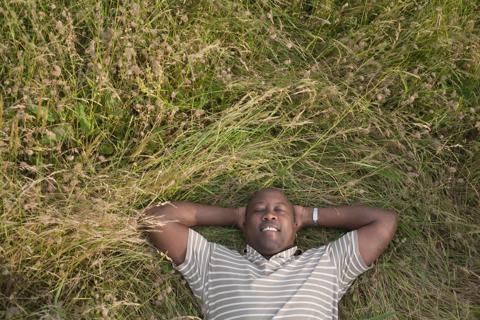Ayurveda is a 5,000-year-old medical system

Ayurvedic medicine is about much more than providing treatment. Ayurveda is one of the world’s oldest medical systems. Originating in India 5,000 years ago, it relies on a natural and holistic approach to physical, mental and emotional health.
Advertisement
Cleveland Clinic is a non-profit academic medical center. Advertising on our site helps support our mission. We do not endorse non-Cleveland Clinic products or services. Policy
But how does it work? Where do you begin? And how do you know if it’s right for you? Integrative medicine specialist Yufang Lin, MD, yoga therapist Paula Brown, C-IAYT, E-RYT 500, and yoga therapist Renee Warren, C-IAYT, RYT 500, share what they know about the practice of Ayurveda.
The word “Ayurveda” is derived from Sanskrit and means “science of life.” In Ayurveda, there’s an underlying belief that everything in life is connected. Because of this, general health and wellness rely on achieving balance and harmony.
When a person is imbalanced or stressed, they’re likely to develop disease. Ayurveda focuses on implementing lifestyle interventions and natural treatments, therapies and remedies to provide balance among your physical body, mind, spirit and the world around you.
“Some ancient healing traditions, such as traditional Chinese medicine (TCM) and Ayurveda, suggest all individuals have energy,” says Dr. Lin. “Chinese medicine calls this energy system chi; Ayurveda calls this prana. Just like blood has to flow smoothly and in balance, Ayurveda suggests the energy system in the body also has to flow well and be in balance for us to be healthy.”
Balance is achieved with the help of a healthy diet, restful sleep, regular exercise and stress management. If needed, botanicals, exercise, activities that promote mindfulness and other resources may offer additional support.
Advertisement
Every individual is unique, and Ayurveda defines a person’s specific constitution, or prakriti. According to Ayurveda, these prakriti determine your physical, psychological, behavioral and immunological traits. Different constitutions respond to different treatments, so what works for you might not work for someone else.
According to Ayurvedic philosophy, each person’s constitution is made up of three doshas: vata, pitta and kapha. You can think of doshas as energy types: each of these doshas is believed to dictate your emotional strengths and weaknesses, the foods your body needs and wants, the exercises that might work the best for you and more. Ayurvedic practitioners seek to help you find a balance among all three doshas. When the doshas are out of balance, illness occurs. The Ayurvedic practitioner uses nutrition, stress management, exercise and sometimes herbs to help a person regain health and balance.
“Like increases like, so if you have trouble getting up and getting moving, you probably don’t want to do a restorative yoga practice in the morning if you need to build energy and get going,” says Warren. “Instead, you might want to do some sun salutations where you’re not holding postures for very long.”
Here’s what you need to know about each dosha.
According to Ayurveda philosophy, vata controls the flow of movement in your body and mind. Vata determines your flexibility, the movement of your muscles and joints, your blood flow and the way you breathe.
If you’re dominant in vata, you’re creative, flexible and quick to action. As you’re snappy, you also have the downside of worrying or feeling anxious when you have too much vata. For someone with excessive vata, an Ayurvedic practitioner may suggest grounding techniques like sticking to a regular sleep-eat schedule, meditation, rest and relaxation. “A walking meditation is a lovely meditation for someone that feels like they can’t sit still, especially if it’s in the morning as the sun is coming up,” says Warren.
Pitta is loosely translated as “fire,” so think of this energy type as something that consumes other things. Pitta, in Ayurvedic theory, is responsible for controlling digestion, hormones and metabolism.
If you’re dominant in pitta, you tend to be dominant in leadership, competitive, strong-willed, confident and focused. In Ayurveda, when your pitta is off balance, you might be quick to anger or excitement, make rash decisions or participate in self-destructive behavior. Pitta imbalance also presents itself in inflammation, rashes, skin conditions like eczema or acne, and digestive issues like irritable bowel syndrome, diarrhea and more. To balance pitta, Ayurvedic practitioners might suggest participating in cool, calming activities. Eating cooler foods or a Mediterranean diet that helps with inflammation are also possible suggestions.
Advertisement
Kapha is the element that holds everything together, from your cells to your muscles, bones and ligaments. The densest of the three doshas, kapha is known for endurance and lubrication.
If you’re dominant in kapha, you may be comfortable sticking to a routine. Emotionally, you like to set expectations and hold to them. Kapha-dominant individuals are loyal, nurturing and dependent on others. But when imbalanced, kapha can cause excessive fatigue, weight gain, swelling, disinterest in new activities and inability to let things go. To combat an imbalance of kapha, essential oils may be helpful. Individuals are steered away from comfort foods to lighter fare like fruits and vegetables in smaller portions throughout the day. Increasing physical activity to get blood flowing is also a good practice.
In India, Ayurveda is considered a formal medical care system equivalent to conventional Western medicine. It’s estimated that 80% of India’s population of 1.2 billion people use some form of traditional Ayurvedic medicine. In India, there are many government and private Ayurvedic medical schools, clinics and hospitals. And Ayurvedic medicine is an important aspect of traditional Indian culture. Proponents of Ayurveda feel strongly in its effectiveness, citing its history of use over millennia.
Advertisement
However, very few rigorous studies that meet Western standards of scientific validity have been conducted. Even fewer have demonstrated effectiveness.
Of particular concern is that approximately 20% of Ayurvedic medicines fall into a class called Rasashastra. This category intentionally combines and processes minerals, metals and gems for therapeutic purposes. The resulting Bhasmas, depending upon their raw ingredients, may or may not be safe. Some Bhasmas are intentionally made with lead and mercury. These have been associated with hundreds of reported cases of lead poisoning. Some Ayurvedic proponents state these are safe based on their preparation, and those that cause toxicity weren’t prepared properly. However, there isn’t any published scientific evidence to support these claims.
Studies by Cleveland Clinic’s Chair of Wellness & Preventive Medicine Robert Saper, MD, MPH, have shown approximately 20% of Ayurvedic medicines available in the marketplace and online contain potentially harmful levels of lead, mercury and arsenic. Because of this, Dr. Saper suggests avoiding any products that contain Bhasmas in their ingredients.
“The source of heavy metals in Ayurvedic medicines can come from intentional addition, contamination from the environment and contamination during the manufacturing process,” says Dr. Saper. “Regardless of the cause, lead is toxic and there are no safe levels to consume it.”
Advertisement
Although Ayurveda doesn’t have a nationally recognized licensure program in the United States, some institutions offer Ayurvedic certifications. The National Ayurvedic Medical Association (NAMA) has also pushed for raising awareness about the Ayurvedic profession in the United States and an increase in scientific research to validate its existence.
If you’re interested in pursuing Ayurveda, you should speak with your healthcare provider to ensure any herbal medicines have been tested by an independent laboratory such as Consumerlab.com for heavy metals and other contaminants. By working with an integrative medicine physician, you can receive a holistic evaluation that will help you bridge both traditional and complementary medicine techniques safely and effectively.
“We evaluate the person holistically through mind, body and spirit perspective,” says Dr. Lin. “We dive into your lifestyle, how you’re eating, how you’re taking care of yourself, your thinking process, your spiritual beliefs, your stress management, your exercises and your environment. We take all these factors into consideration to understand what may have contributed to your imbalance, then make a plan to help you restore balance.”
From there, you can work with your healthcare provider to find small lifestyle changes you can make each day that can benefit you and provide balance. Some lifestyle changes may include adjusting your bedtime, carving out a space for self-care and reflection, or even just increasing your physical activity.
“There are all sorts of things you can do to create this routine to establish greater balance according to Ayurvedic principles,” says Warren.
“In Ayurveda, food is medicine,” notes Dr. Lin. “What you eat matters. You can change your diet to support your health.”
Working with a specialist, you may incorporate specific safe herbs like ashwagandha, turmeric and ginger to help with stress, anxiety and inflammation.
But Dr. Lin warns that not all supplements available in the U.S., including Ayurvedic supplements, have gone through the rigorous safety, effectiveness and quality criteria used by the U.S. Food and Drug Administration (FDA) in drug testing.
“I would caution people to be wary of supplements because some of the Ayurvedic medicines are contaminated with heavy metals, so safety can be an issue,” she adds.
Speak with your healthcare provider before beginning any supplements to ensure they’re safe.
“Many of these ancient healing traditions, such as traditional Chinese medicine and Ayurvedic medicine, are whole medical systems with much history and wisdom behind them,” says Dr. Lin. “Integrative medicine is about integrating those concepts with mainstream medicine in a safe and effective way by applying current modern scientific principles. It’s not about one or the other.”
Ayurvedic medicine has been around for thousands of years. But there’s still a lot of research needed for Ayurveda to be considered for true integration into Western medical systems.
“If you are interested in integrating Ayurveda into your lifestyle, you should see an integrative medicine specialist,” advises Dr. Lin. “An easy way to start would be exploring Ayurvedic recipes and cooking with Ayurvedic herbs and spices.”
Learn more about our editorial process.
Advertisement

This traditional Chinese medicine practice may boost mental health, immune function, balance and more

This treatment may reduce stress, relieve pain and allergy symptoms, and help with sinus pressure

This purple perennial has many uses, including sleep hygiene, reducing inflammation and pain, and elevating mood

It involves tapping specific points on your body while focusing on an emotion or issue you want to release

Supplements with colloidal silver offer no proven health benefits and could be harmful

Connecting with the Earth and its energy might improve your mental and physical health — but it’s not a cure-all

These terms are becoming outdated as providers turn to an ‘integrative’ approach instead

A couple essential oils may be used with caution, but there are safer and more effective options

If you’re feeling short of breath, sleep can be tough — propping yourself up or sleeping on your side may help

If you fear the unknown or find yourself needing reassurance often, you may identify with this attachment style

If you’re looking to boost your gut health, it’s better to get fiber from whole foods